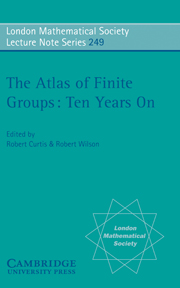Book contents
- Frontmatter
- Contents
- Introduction
- Addresses of registered participants
- Addresses of non-participating authors
- Programme of lectures
- Conference photograph and key
- Symmetric presentations and orthogonal groups
- A constructive recognition algorithm for the special linear group
- Relations in M666
- A survey of symmetric generation of sporadic simple groups
- Harish-Chandra theory, q-Schur algebras, and decomposition matrices for finite classical groups
- The Meataxe as a tool in computational group theory
- Branching rules for modular projective representations of the symmetric groups
- Characters and surfaces: a survey
- On the characterization of finite groups by characters
- Finite linear groups of small degree
- Minimal parabolic systems for the symmetric and alternating groups
- Probabilistic methods in the generation of finite simple groups
- Condensing tensor product modules
- Intersections of Sylow subgroups in finite groups
- Anatomy of the Monster: I
- An integral ‘Meat-axe’
- Finite rational matrix groups: a survey
- Chamber graphs of sporadic group geometries
- An Atlas of sporadic group representations
- Presentations of reductive Fischer groups
- A brief history of the ATLAS
Minimal parabolic systems for the symmetric and alternating groups
Published online by Cambridge University Press: 19 May 2010
- Frontmatter
- Contents
- Introduction
- Addresses of registered participants
- Addresses of non-participating authors
- Programme of lectures
- Conference photograph and key
- Symmetric presentations and orthogonal groups
- A constructive recognition algorithm for the special linear group
- Relations in M666
- A survey of symmetric generation of sporadic simple groups
- Harish-Chandra theory, q-Schur algebras, and decomposition matrices for finite classical groups
- The Meataxe as a tool in computational group theory
- Branching rules for modular projective representations of the symmetric groups
- Characters and surfaces: a survey
- On the characterization of finite groups by characters
- Finite linear groups of small degree
- Minimal parabolic systems for the symmetric and alternating groups
- Probabilistic methods in the generation of finite simple groups
- Condensing tensor product modules
- Intersections of Sylow subgroups in finite groups
- Anatomy of the Monster: I
- An integral ‘Meat-axe’
- Finite rational matrix groups: a survey
- Chamber graphs of sporadic group geometries
- An Atlas of sporadic group representations
- Presentations of reductive Fischer groups
- A brief history of the ATLAS
Summary
Abstract
We determine the minimal parabolic subgroups and minimal parabolic systems of the alternating and symmetric groups with respect to a Sylow 2-subgroup.
Introduction
Using the finite groups of Lie type as a role model Ronan and Smith [5] and Ronan and Stroth [6] studied certain subgroups of the sporadic finite simple groups. The underlying idea was to obtain geometric structures analogous to buildings via suitable systems of subgroups in each of these groups. Here we investigate the alternating and symmetric groups for the prime 2 from a perspective similar to [6], the emphasis being on minimal parabolic subgroups, which we now define.
Let G be a finite group, p a prime dividing the order of G and T ∈ Sylp(G). Put B = NG(T). Then a subgroup P of G which properly contains B is called a minimal parabolic subgroup (of G) with respect to B if B is contained in a unique maximal subgroup of P. Note that, unlike Ronan and Stroth [6], here we do not require that OP(P) ≠ 1. We denote the collection of minimal parabolic subgroups of G with respect to B by M(G, B). In the case when G is a finite group of Lie type defined over a field of characteristic p, the subgroups in M(G, B) are indeed minimal parabolic subgroups of G and our nomenclature coincides with the standard one.
Let P1, …, Pm ∈ M(G, B). Then we call S = {P1, …, Pm} a minimal parabolic system of rank m provided that G = 〈S〉 and no proper subset of S generates G.
Information
- Type
- Chapter
- Information
- The Atlas of Finite Groups - Ten Years On , pp. 149 - 162Publisher: Cambridge University PressPrint publication year: 1998
Accessibility standard: Unknown
- 2
- Cited by
